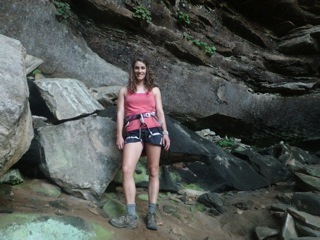Each summer the KBS LTER supports students to participate in the Research Experiences for Undergraduates (REU) program, funded by the National Science Foundation. This is part of a larger REU and intern program at KBS. Monica Cooper, a senior at Kalamazoo College, writes about her REU experience working with KBS LTER scientists Dr. Sarah Emery and Brad Gottshall.~~~~~~~~~~~~~~~~

KBS LTER undergraduate researcher Monica Cooper prepares a 96 well micro plate in Dr. Sarah Emery’s lab at the University of Louisville. Photo credit: Phung Nguyen
It wasn’t often that I thought about dirt before starting my Research Experiences for Undergraduates (REU) this past June. Since then, I have learned that it’s called soil, never dirt, and I have been learning a bit about why it’s so important. This is the first real research opportunity I have had, and it’s been really exciting to work side-by-side with graduate students and to get an idea of what research is actually like. I am going into my senior year at Kalamazoo College in Michigan, and this experience has gotten me really excited about pursuing a Masters and/or PhD after I graduate.
My REU is at the University of Louisville working with PhD student Brad Gottshall in Dr. Sarah Emery’s lab. I am studying Arbuscular Mycorrhizal Fungi (AMF), which are symbiotic fungi that colonize the roots of most plants. AMF provide the plant with essential soil nutrients such as phosphorus by accessing spaces between soil particles that even the smallest plant root cannot reach. In exchange, the fungus receives photosynthetic carbon compounds from the plant. I have also been studying a glycoprotein called Glomalin that is produced by AMF and could be an important part of soil aggregation and soil carbon sequestration. AMF and Glomalin are important for soil health and the success of crops. They are thought to be possible tools to help plants survive under drought conditions.
Weigh soil, add citrate, autoclave, centrifuge, repeat. That’s pretty much what I’ve been doing all summer. I have processed 198 1-gram soil samples from the Kellogg Biological Station Long-term Ecological Research (KBS LTER) experiment, part of Michigan State University. For 25 years, this experiment has researched ways that row-crop agriculture can be profitable for farmers and good for the environment. A big part of that is understanding soil and all the components in it.
So far, I have performed the extraction protocol to isolate Bradford Reactive Soil Protein (BRSP), a group of proteins that survive repetitive rounds of autoclaving at 121˚C. BRSP are thought to be composed primarily of Glomalin; at this point in time, there is not yet a technique that can isolate the Glomalin. Glomalin is therefore not sequenced, and its exact molecular weight is unknown. Glomalin is a pesky little protein (aka recalcitrant to extraction), but by using this citrate extraction followed by the Bradford Assay—a spectroscopic method to compare the protein concentrations of the BRSP to a known protein standard curve—we can at least get an estimate. In previous research, it has been found that at the very least, we can compare BRSP levels from crop to crop and see if they increase or decrease along with AMF levels. It has previously been found that tilling a field disrupts those delicate networks, which would cause Glomalin levels to decrease. In my research I am comparing five KBS LTER treatments: conventional, no till, reduced input, and organic crop management applied to a corn-soybean-wheat rotation, and an early successional “old field” treatment which was abandoned from farming 25 years ago. I want to see if we can find the same patterns in these treatments as previous research has suggested. For example, I expect that we will find a negative correlation between tillage and BRSP levels. I also expect the successional field to have much higher BRSP than the other treatments as it has previously been found that agronomic activity decreases Glomalin and AMF levels.
I hope to be a community level ecologist, and never really pictured myself in a lab, indoors, for a whole summer. Luckily, Dr. Emery takes us all “botanizing” every Thursday for a couple of hours. We have gotten to explore parks all around Louisville, and I’ve gotten a fair bit of practice at using the Dichotomous Key to identify plants. In my down time, I try to get outside as much as I can. I’ve explored Jefferson Memorial Park just outside Louisville and Red River Gorge, a rock climbing mecca about two hours away.
Through this REU, I have learned an incredible amount about soil ecology, botany, and what research really is. I have learned about the repetitive and sometimes frustrating nature of ecology. It has been a challenge, but with that has come a great sense of accomplishment.
